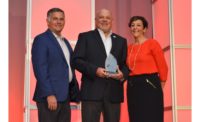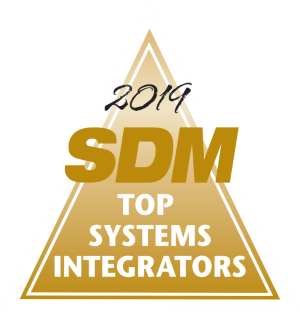ESA Summit 2016 Challenges Dealers to Be Bigger Leaders

Kelly Bond, senior vice president of business development at Alarm Capital Alliance and ESA membership committee chair, receives the 2016 Sara E. Jackson Memorial Award.
PHOTO BY SDM STAFF

In the legislative coalition, ESA board members and guests discuss several important issues.
PHOTO BY SDM STAFF

Marshall Marinace, the Morris F. Weinstock Person of the Year, is locked up for charity in the town jail during a diamond event sponsored by Interlogix.
PHOTO BY SDM STAFF

ESA President Marshall Marinace accepts the honor of being named the 2015 Morris F. Weinstock Person of the Year
PHOTO BY SDM STAFF

Speaker and author Shelley Row, Shelley Row Associates LLC, speaks in one of the informative breakout sessions about ways to stop time-wasting, brain-draining mistakes.
PHOTO BY SDM STAFF

One of several “speed networking” sessions in which attendees met with each other in an informal setting while enjoying drinks and hors d’oeuvres.
PHOTO BY SDM STAFF

Adele Cehrs, founder and CEO of Epic PR Group, hosts the interactive session “Marketing Report Card.”
PHOTO BY SDM STAFF

ESA Vice President/President-Elect Angela White, along with current President Marshall Marinace, presents the ESA leadership awards.
PHOTO BY SDM STAFF








The 2016 ESA Leadership Summit drew the largest crowd since its format was changed.
More than 250 people registered for the event, which took place at the Wild Horse Pass Hotel and Casino just outside of Phoenix. Shannon Murphy, vice president of sales and marketing, ESA, said that was the highest number they’ve had since changing to the current format.
Driven by this year’s theme — Link. Learn. Lead. — the goal of the conference was to deliver businesses intelligence for growing companies, and ESA accomplished that goal with a variety of educational meetings, general sessions and breakout sessions.
“We brought in speakers from outside the industry to offer fresh perspectives to attendees,” Murphy said. “Anyone interested in growing and leading their business needs to be here.”
In keeping with the theme, ESA launched its new mentor/mentee program at the conference. It is a nine-month professional development program in which mentors and mentees are paired up; the 2016 inaugural class has 16 pairs, and 2017 applications will be accepted this summer.
In the first general session, Robert Harris, CAE, emphasized the importance of having strong state associations: “I believe that we make a stronger ESA if we are able to say, ‘I’ve got this strong state association.’”
He also encouraged leaders to spend time on board orientation, identifying future leaders. “You will not be here in 2020 unless you are a sustainable organization with your revenue, with the value to your members and with a good leadership team.”
Harris talked mainly about the role of associations and the responsibilities board members have to advance the electronic security, life safety and the integrated systems industry for the benefit of members, customers and public safety, citing ESA’s mission statement. Harris said all board members should know immediately what the ESA mission statement is. “In 2009 the IRS said if you serve on a board of directors, you should be able to articulate the mission statement. So do something — keep it in your pocket … to be prepared.”
Associations are being attacked in many different ways, Harris said. “The IRS closed down 275,000 of them just a couple years ago,” he said, encouraging ESA board members to make sure that in addition to knowing their mission statement, they are advancing it as a way to remain relevant. “Are you ready for the scrutiny that is now being applied?” Harris asked.
He gave practical suggestions to help boards ensure they are fulfilling their purposes without violating anti-trust laws.
Harris encouraged the audience to go to his website, www.nonprofitcenter.com, for many free resources designed to help associations clarify their roles and responsibilities and stick to those goals.
Following the session, ESA Vice President/President-Elect Angela White, along with current President Marshall Marinace, presented the ESA leadership awards:
- Chapter Executive Director of the Year: Jeanne Palmer, Nevada Security Association
- Chapter President of the Year: Jeremy Bowman, Alabama Alarm Association
- Chapter Newsletter of the Year: Alabama Alarm Association (The Contact)
- NTS Instructor of the Year: Joel Kent
- Chapter Website of the Year: Tennessee Electronic Security Association (www.tnesa.com)
- Chapter of the Year: Nevada Security Association
In the second general session, full-time speaker, trainer and consultant Dennis Snow discussed performance excellence. Snow, who launched a division of the Disney Institute responsible for consulting with some of the world’s largest companies, summarized his message like this: “Creating experience always comes down to our people.”
“Culture,” Snow said, interspersing his points with anecdotes and illustrations from his time at Disney, “is what we want customers to say about their experience.” Snow explained that culture is created by having three things: vision, accountability and involvement.
A proper vision, he said, should operationalize a service culture. Snow gave practical advice for improving that culture by telling leaders to focus on attitude rather than just knowledge and experience when interviewing and selecting new employees. Also, he told them to study their best people.
Next, a proper vision involves training and communication that engages the heart, “ensuring the employee is proud the organization, he understands the true product and he understands what is expected of him.”
Secondly, there should be accountability by operationalizing expectations. “Intolerable service exists because intolerable service is tolerated,” Snow said, describing the way the Disney culture operationalized expectations from its employees in things like picking up trash as they walked through the park.
Thirdly, involvement means engaging the minds of employees and removing barriers to excellence.
In the last general session, Gene Marks, columnist for The Washington Post, Forbes and others, and owner of the Marks Group PC, spoke about growth opportunities over the next two years, focusing on the latest political, economic and technological trends that will dominate the industry through 2017.
“People that have survived share one thing,” Marks said. “They are always looking ahead.”
Marks said the No. 1 issue in the next couple of years will continue to be healthcare. He offered five things smart people are doing in 2016, not as recommendations, but more as options to be aware of:
- dropping coverage and paying penalties;
- working the loopholes (“skinny plans” and shifting to Medicaid);
- shifting costs by choosing bronze plans with high deductibles and HSAs;
- self-insuring and retaining only a catastrophic plan; and/or
- choosing a hybrid of sorts — paying out of pocket to a certain point before the bronze plan kicks in.
Marks pointed out five major issues with healthcare to keep an eye on:
- enrollment is not keeping up with expectations;
- medical loss ratios are too high;
- risk corridors are limited after 2016 — a 50 percent to 80 percent Federal reimbursement for costs coverage will be ending soon, leaving all costs to the states;
- 2016 rate requests are 30 percent to 50 percent higher in some states; and
- several big insurance companies are pulling out of the exchange.
In addition to the big changes to healthcare and the possible impact of the coming presidential election, Marks discussed the upward trending minimum wage, overtime law changes in 2016, and the national trend toward more paid time off.
Marks advised company leaders to talk to their accountants and determine if their tax strategies are maximizing retirement plans, among other things. One final word of advice Marks gave was for companies to get cyber insurance.
Following this session, Kelly Bond, senior vice president of business development at Alarm Capital Alliance and ESA membership committee chair, received the 2016 Sara E. Jackson Memorial Award.
Interactive Sessions
On the second day of the conference, Kelly Bond, Steve Firestone and Steve Paley facilitated an interactive session called “What Keeps You up at Night?”
Some of the key issues raised were manufacturers producing new technology — IP-based, etc. This was presented as the biggest factor.
Another issue was the lack of younger people joining the industry. Those who self-identified as Millennials were asked to stand give feedback about what they look for in a company, how they view their careers, what would cause them to stay or leave, and other questions pertinent to workforce development. Paley talked about the importance of hiring “fully formed adults.”
Some practical takeaways included hiring from non-security pools, partnering with local school districts to introduce young people to the possibility and benefits of entering the security market and developing company differentiation to better clarify what companies want their customer experience and unique selling proposition to be.
On the third day, Adele Cehrs, founder and CEO of Epic PR Group, hosted the interactive session “Marketing Report Card.”
Cehrs discussed what customer behaviors matter and how they should impact sales strategies and messages. “The essence of marketing hasn’t changed,” Cehrs said, “only behavior. You’re not marketing stuff to people; you’re marketing what stuff means to people.”
Cehrs gave what she called “rules for building a money-making machine,” asking, “Do you know who your customer is or who the decision maker is in their home or business? Do you know what your customer does on Monday morning and on Sunday morning and why [he or she does it]?”
Cehrs explained that companies must determine what they are best at and then “pick a lane,” creating a perception that you are the thought leader in that area through white papers, seminars, etc.
Some practical questions said executives must ask are:
- Do you have a sales and marketing playbook?
- Do you have a touchpoint matrix? (There should be a minimum of seven touches.)
- Do you know what’s working and what’s not?
- Do you have a mobile strategy, CRM or data analytics for your website?
- Do you have third-party credibility?
Cehrs also explained how you can influence your customers to buy through authority, reciprocity, social proof, scarcity, likability, and commitment and consistency.
Breakout Sessions
Throughout the conference, there were a number of breakout sessions. In the legislative coalition, ESA board members and guests discussed several important issues. The federal issues they discussed were federal telecommunications, SIA-ESA joint discussion on national issues such as school security, federal legislation and United for Patent Reform.
Some legislative trends discussed were the electrical licensing bills in several states, regulatory issues, “Buy American” legislation and e-waste/recycling legislation.
Also taking place on day one of the conference was the ESA Board of Directors Meeting. Several of the main issues presented were a trial promotion program for new regular members, membership trends and retention trends. The 2016 through 2018 strategic plan was presented. ESA’s four strategic initiatives are: resource, advocate, connect, and educate.
In another breakout session, Matt Meade, co-chair of cybersecurity and data protection group at Buchanan Ingersoll & Rooney, discussed data security and privacy — why it matters and what you need to know.
Some key takeaways Meade offered were to be proactive, implement best practices and to have a safe harbor for encrypted data. Some practical ways Meade advised companies to implement best practices were by having a written information security program, having a record-destruction policy, having a breech-response plan, having a policy addressing the security of customers’ and employees’ social security numbers, and having a basic technical control policy.
Interlogix sponsored an event at Rawhide Western Town and Steakhouse. Attendees could practice archery, throw hatchets at targets, walk through the Old Western town, or listen to live music. After a hearty bar-b-que meal, Marshall Marinace was named the Morris F. Weinstock Person of the Year — and promptly marched off to the town jail where he was locked up for charity.
The conference ended with a closing event at Chrome Nightclub. Overall, the conference was a practical and educational event that was well-received and which dealers found to be helpful.
Looking for a reprint of this article?
From high-res PDFs to custom plaques, order your copy today!
















